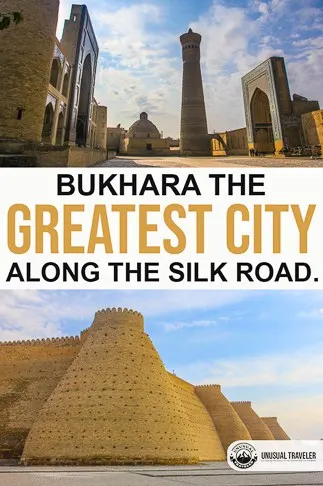The ancient Bukhara, Silk Road’s historic city in Uzbekistan, was once one of the most important stops along the Silk Road.
Today, it is one of the best examples of well preserved Islamic cities of Central Asia of the 10th to 17th centuries.
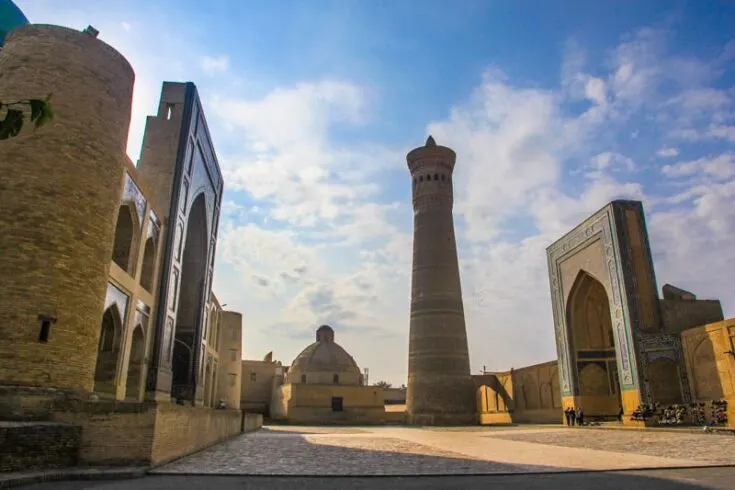
In modern times, the people visiting are mostly foreigners wanting to explore this must-see place. It is famous not only in Uzbekistan but in the whole of Central Asia.
Bukhara is, together with Khiva and Samarkand, one of the three must-visit places in Uzbekistan for history nerds.
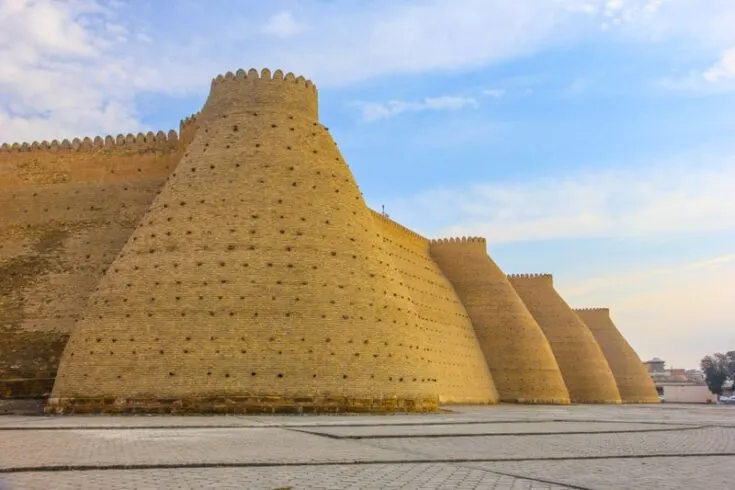
Where is Bukhara City
Where is Bukhara located? It is in modern-day Uzbekistan. Bukhara used to be one of the key stops for ancient travelers and believers ever since the 6th century BC.
It is the fifth-largest city in Uzbekistan and the capital of the Bukhara region.
How to Get to Bukhara
Reaching Bukhara is easy once you are inside Uzbekistan, but it can also be reached with direct flights from Russia. There’s a direct flight from Moscow with Aeroflot (Sky team) and Novosibirsk S7 (One World).
Getting Around Uzbekistan
Bukhara International airport has daily flights to all the larger cities in Uzbekistan. Flying domestically in Uzbekistan is very cheap. A one-way ticket inside the country is normally priced at around 50 USD.
The railway system in Uzbekistan is also world-class. But, if you want to travel to or from Bukhara to smaller places, then shared taxis are your best option.
Trust the Trains
A big surprise for most first-time visitors to Uzbekistan is that the railway network between the big cities is world-class. Tashkent to Bukhara, a distance of 600 km, will now take 3 hours and 20 minutes with the Afrosiyob high-speed train.
And the travel time between Samarkand and Uzbekistan only takes about one and a half-hour by train.
Top Things to Do in Bukhara
The proof is in the pudding, as they say, and the eye-catching sights of Bukhara, Uzbekistan, will help you believe this statement quite easily.
The constructions, architecture, and historical artifacts you will find here can hardly be found anywhere else in the World.
The Historic Center of Bukhara
The heart of Bukhara will steal the show. The skyline of the old town is outlined with lower buildings where nothing much stands out, apart from the mighty towers and minarets set mostly in the center of the old town.
The Historic Center of Bukhara is listed as the UNESCO world heritage site. This title was earned due to exquisite architecture, well-preserved structures, and unique style depicting an era that finished a long time ago.
Once you are here, time will appear to suddenly stop, and you will find yourself in the middle of a tangible memory of the golden days of Bukhara’s glory.
Expect plenty of mosques, minarets, madrassas, and more. Every site competes to take all the attention and make it clear why the World owes a great debt to this city.
Furthermore, it is thought that the very city center hasn’t changed for the past 200 years.
So this is possibly the reason why, once you end up here, you might genuinely feel as if you traveled through time.
The core of the historic city is Po-i-Kalan or Poi Kalan, a monumental square surrounding the famous sights of Kalyan Minaret and Kalan Mosque.
Kalyan Minaret – the Tower of Death
The skyline of Bukhara is dominated by the Tower of Death. It sounds almost a bit scary, but it’s true. Kalyan minaret is its official name.
It is a tall tower made of unique yellow brick, rising up to about 45 meters.
The Minaret dates back to the 12th century. The height was praised during its time because it was the tallest tower in Central Asia.

However, this place was once feared as much as it was praised by the locals. The tower was once used as a death sentence to all who weren’t following the rules.
People were simply taken to the top of the tower and thrown to their death as a punishment and a warning to others.
It was (and still is) one of the key sights of Bukhara. It even survived during the siege imposed by Genghis Khan.
The Minaret stayed intact as this powerful conqueror decided it was worth preserving (not like the Kalan Mosque nearby, which was destroyed).
Kalan Mosque

The Kalan Mosque was built on the site of another mosque that was trashed to pieces at the time of the ruthless Khan’s invasion.
Later, the Kalan mosque was built from the finest Islamic architecture to replicate it and all its glory.
However, it didn’t have an easy history. In the time of the Russian occupation of Uzbekistan, it was shut down and turned into a warehouse.
Today, Kalan mosque is finally free to be what it was meant for – a center for religious worship and general admiration for its splendid architecture.
The mosque is ‘protected’ by a vast rectangular courtyard stretching in front of the entrance.
The courtyard is a beautiful sight, archaic and elegant. Its surrounded by constructions filled with ornaments and delicate decorations.
Straight in front is the entrance to the worship place, which could take in several thousands of believers during its glory days.
Mir-i-Arab Madrasa

A couple of steps away is another pleasure for the eye and mind of a traveler, the Mir-i-Arab Madrassa.
It is a glorious building with two tall domes decorated with blue tiles. Mir-i-Arab Madrassa is one of the main sites in Bukhara.
The Madrassas were and still remain to be a kind of university in the Islamic World. Mir-i-Arab Madrassa is still active, but foreign visitors cannot get inside the madrassa.
However, you can still admire the beauty of the dominant construction and the blue domes from a suitable distance.
Mosaics, façades, and decorations, all typical for Islamic architecture, can be seen here in abundance. This is not a site to be missed.
The Ark of Bukhara
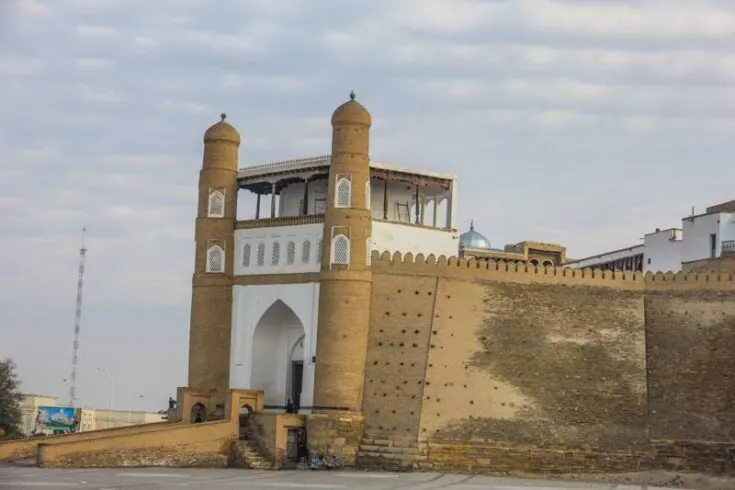
The Ark, also known as the Bukhara Citadel, is a landmark of Bukhara carrying the stories of royals who once ruled the area. It’s massive, built with precision and amazing attention to detail.
The outside of the Ark calls for admiration as much as the inside.
Numerous buildings, museums, remnants of the rooms, and spaces once taken by the rulers will take your attention easily.
The origins of the Ark dates back as far as the 5th century BC and kept being restored and protected as a memory of the overarching power of Bukhara.
Make sure you spend at least a couple of hours here, enjoying not only the complex but also the view of the magnificent city.

Char Minor
Char Minor is another madrassah you must visit in Bukhara. It is located a bit further away from the historic center of the city, but it is worth the effort.
With its four tall minarets, tiled in blue, it stands out on the outline of the city, begging for your attention.
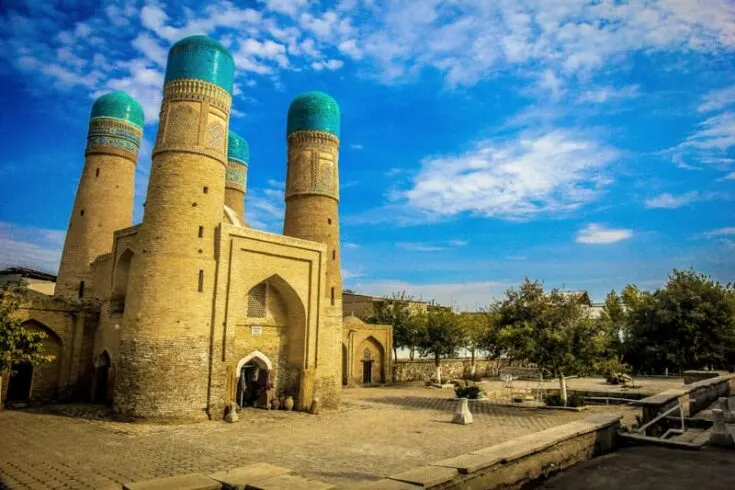
It was also supposed to be a stopping point for people traveling to a Silk Road city and a place where all different parts of the World were to be represented no matter of nation or religion.
Bukhara was always reminding the World that we all are one.
The architecture is a bit unusual and seems like it comes from another world. It was built back in the 19th century with the aim of reaching the glory of the Taj Mahal in India.
Bukhara Bazars
Bukhara has been a center for trade since forever. Being a merchant here is almost a sacred legacy of the past. And bazaars are the real place for the trade of Bukhara to show off.
Carpets, textile, spices, art, and craftsmanship at their best can be found in many of them.
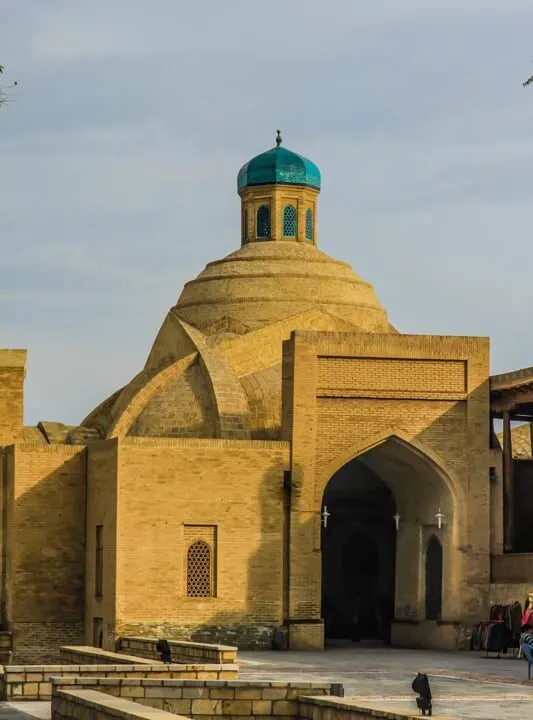
Pay attention to carpets made here especially, as they are another proof of wisdom and creativity of the Uzbek nation. The carpets have a special place in the hearts of the nation.
Its long tradition, specific ways of knitting and coloring the silk, and the extensive beauty of details knitted with precision can easily amaze you.
At first glance, the prices of the carpets seem quite steep. However, once you learn that about 85% of the price for a carpet is paying off workers who had to put an exquisite amount of patience and skill into the work, the prices almost become understandable.
Best Time to Visit Bukhara
When it comes to visiting Bukhara, Uzbekistan, then Spring and autumn are the prime times.
You will avoid the heat of the summer this way (where temperatures reach an excess of 40 degrees celsius).
Don’t go too late, though, because winters in the Central Asian deserts can be tough, but with almost no foreign tourists around.
So there´s a big chance that you will get some of the historic buildings for yourself. But then be sure that your accommodation has heating.
Bukhara City History
Once upon a time, Bukhara was one of the most important cities in the World; however, now you barely hear of Bukhara anymore, even tho more and more tourists are re-discovering the city once again.
The city has a history going back to more than two thousand years ago. Bukhara became well known for at least two reasons: its position along the Silk Road and its long-lasting culture.
Bukhara was an essential economic and cultural center in Central Asia for a long time.
The ancient Persian city served as a major center of Islamic culture for many centuries and became a major cultural center of the Caliphate in the 8th century.
Bukhara was also one of the main cities on the ancient path of the Silk Road. Bukhara was connecting the Far East with the Far West, enabling trade, connectivity, and cultural exchange.
At the same time, it was a city of knowledge, languages, art, and architecture.

Bukhara was an oasis on the Silk Road. Its many channels were used to help quench the thirst of travelers and their horses.
Today, most of the channels are gone due to Russians who sealed them off during Soviet time. Still, a couple of the channels remain to remind the visitors of the former purpose.
Bukhara was the center for protecting and expanding the knowledge of the World. From medicine to art, it seemed that all the branches of knowledge were developing here.
Scientists, artists, theologists, master craftsmen, and merchants they all were gathering in the safety of the city.
This was a place where great minds were welcomed and incentivized to further explore.
It is also thought that thanks to this place that, the essence of the Persian language was protected.
Bukhara was a multicultural city where every religion had space to flourish. Islam, Christianity, Judaism, Buddhism, and many others all had their places in this city.
Most of the World praised Bukhara, while the conquers despised it. The same goes for other silk road cities such as Samarkand in Uzbekistan or Persepolis in Iran, the city of Bukhara was the target of great army men such as Genghis Khan.
But even this ruthless ruler had moments of mercy because he loved parts of the city’s architecture.
Final Thoughts on Bukhara
Bukhara is definitely a city that should be added to your travel bucket list. It has everything from bazaars, where you can shop for hand-crafted items, to historical and cultural landmarks.
The locals are more than happy to provide you with tours of the landmarks if you ask around.
Prepare yourself for a spring or autumn trip to this magnificent city in order to beat the extreme heat and cold of summer and winter. Trust me; you won’t regret it!
